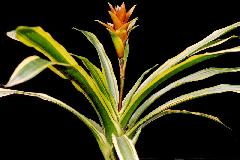
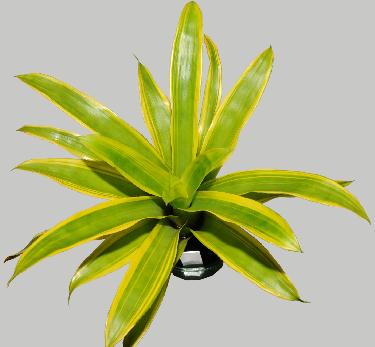
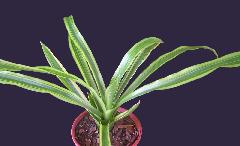
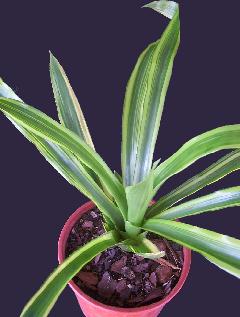
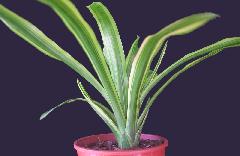
“NIDULARIUM BILLBERGIOIDES (Schultes f.) L. B. Smith in Journ Brom Soc. 25(2): 80. 1975
Nidularium billbergioides (Schultes f.) L. B. Smith is a charming small, upright-growing species native to southern Brazil. If differs from the regular conception of a nidularium in that the inflorescence, instead of being deep in the heart of the plant, appears on the end of a stem, usually 9 to 10 inches above the center of the plant. The leaves are soft, medium to dark green, and measure up to 20 inches in length and l ½ inches in width. The bracts are either burnt orange in color or bright yellow--this latter usually being called var. citrinum. Petals are white. The species is generous with offshoots, the new plants appearing on the ends of stolons. This graceful plant is easy to grow. It is tidy in habit and the inflorescence lasts in color for several months, thus making it good houseplant.
The plant pictured above is of the variegated form that originated in the nursery of Hans Gulz in West Germany and now available in nurseries in the United States. In every way it is similar to the plain green leaved species. Mr. Gulz also grows a form with dark red foliage which he calls folia rubra.”
I had never seen a variegated form so I asked Ross Little if he knew of such a plant. Surprise, surprise he was growing a plant as ‘Variegata’ which had been in the possession of Pinegrove Nursery, NSW since 1981. Of greater importance is a plant obtained in 1985 from Ede Schaefer in Adelaide and we know he had close connections with Gulz. So this plant has survived many years without a proper name and is why I believe we should call it ‘Gulz’. The photo as published in 1975 does show orange primary bracts which links to Ross’s plant. No mention is made about colour of variegations and although the photo shows pale yellow striations you can never be sure of the actual colour from photos of that vintage. Cultural conditions have also to be considered.
Finally we believe that folia rubra has already been captured as Canistropsis ‘Plum’